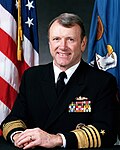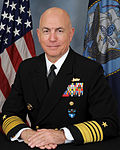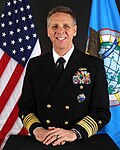| No. | Portrait | Name | Tenure as titleholder | Positions held | Ref |
|---|
| Date received | Date relinquished | Time as titleholder |
|---|
| 1 |  | Admiral
Lee Baggett Jr. | November 4, 1988 | December 9, 1988 | 35 days | Commander-in-Chief,
United States Atlantic Command (1985-1988) | [6] |
| 2 |  | Rear Admiral
Lawrence Layman | December 9, 1988 | February 28, 1989 | 81 days | Director of Space, Command and Control (1986-1989) | [6] |
| 3 |  | Vice Admiral
Albert J. Herberger | February 28, 1989 | March 21, 1990 | 1 year, 21 days | Deputy Commander-in-Chief,
United States Transportation Command (1987-1990) [7] | [6] |
| 4 |  | Vice Admiral
Joseph S. Donnell III | March 21, 1990 | January 31, 1991 | 316 days | Commander, Naval Surface Force, U.S. Atlantic Fleet (????-1991) | [6] |
| 5 |  | Admiral
David E. Jeremiah | February 1, 1991 | February 28, 1994 | 3 years, 27 days | Vice Chairman of the Joint Chiefs of Staff (1990-1994) | [6] |
| 6 |  | Vice Admiral
David M. Bennett | March 1, 1994 | August 25, 1995 | 1 year, 177 days | Commander, Naval Surface Force, U.S. Pacific Fleet (1990-1992)
Naval Inspector General (1992-1995) | [6] |
| 7 |  | Vice Admiral
Philip M. Quast | August 26, 1995 | February 14, 1997 | 1 year, 172 days | Commander, Military Sealift Command (1995-1997) [8] | [6] |
| 8 |  | Rear Admiral
George F.A. Wagner | February 15, 1997 | April 30, 1998 | 1 year, 74 days | Commander,
Space and Naval Warfare Systems Command (1995-1998) | [6] |
| 9 |  | Rear Admiral
George A. Huchting | May 1, 1998 | January 14, 1999 | 258 days | Program Executive Officer for Surface Combatants (1991-1998) | [6] |
| 10 |  | Rear Admiral
Dennis R. Conley | January 14, 1999 | March 31, 1999 | 76 days | Commander, Mine Warfare Command (1996-1999) | [6] |
| 11 |  | Rear Admiral
James B. Ferguson III | April 1, 1999 | June 1, 1999 | 61 days | Commander, Western Hemisphere Group (????-1999) | [6] |
| 12 |  | Vice Admiral
James F. Amerault | June 2, 1999 | July 24, 2001 | 2 years, 52 days | Deputy Chief of Naval Operations
(Fleet Readiness and Logistics) (1998-2001) [9] | [6] |
| 13 |  | Vice Admiral
Rodney P. Rempt | July 25, 2001 | May 21, 2007 | 5 years, 300 days | President of the Naval War College (2001-2003)
Superintendent of the United States Naval Academy (2003-2007) | [6] |
| 14 |  | Admiral
Michael Mullen | May 22, 2007 | December 16, 2011 | 4 years, 208 days | Chief of Naval Operations (2005-2007)
Chairman of the Joint Chiefs of Staff (2007-2011) | [6] |
| 15 |  | Admiral
John C. Harvey Jr. | December 16, 2011 | September 14, 2012 | 273 days | Commander,
United States Fleet Forces Command (2009-2012) | [10] |
| 16 |  | Vice Admiral
John Terence Blake | September 14, 2012 | December 17, 2012 | 94 days | Deputy Chief of Naval Operations for Integration
of Capabilities and Resources (2012) [11] | [12] |
| 17 |  | Vice Admiral
Michael A. Lefever | December 17, 2012 | May 7, 2014 | 1 year, 141 days | Director, Strategic Operational Planning,
National Counterterrorism Center (2011-2014) | [12] |
| 18 |  | Admiral
Samuel J. Locklear | May 7, 2014 | June 22, 2015 | 1 year, 46 days | Commander,
United States Pacific Command (2012-2015) | [12] |
| 19 |  | Admiral
Kurt W. Tidd | June 22, 2015 | October 22, 2018 | 3 years, 122 days | Assistant to the
Chairman of the Joint Chiefs of Staff (2013-2016) [13]
Commander,
United States Southern Command (2016-2018) | [14] |
| 20 |  | Admiral
Philip S. Davidson | October 22, 2018 | April 30, 2021 | 2 years, 190 days | Commander,
United States Indo-Pacific Command (2018-2021) | [15] |
| 21 |  | Admiral
Christopher W. Grady | April 30, 2021 | September 30, 2025 | 4 years, 156 days | Commander,
United States Fleet Forces Command (2018-2021)
Vice Chairman of the Joint Chiefs of Staff (2021–2025) | [5] |






















